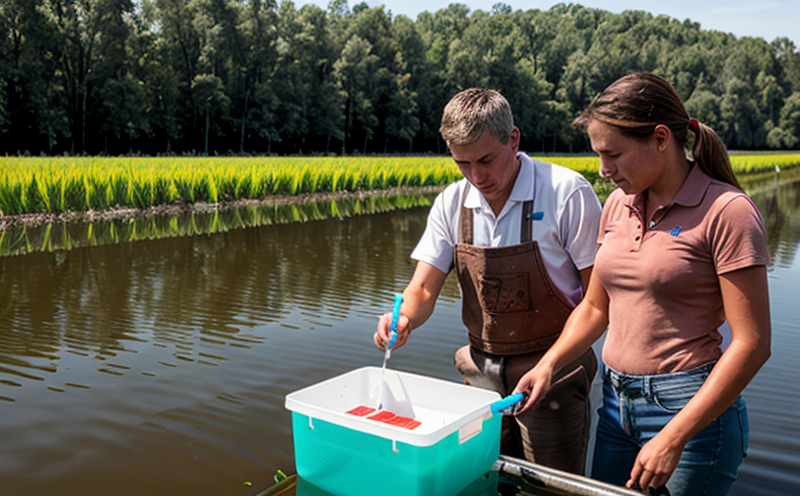Chemical Oxygen Demand (COD) Testing in Irrigation Water
The chemical oxygen demand (COD) of irrigation water is a critical parameter that measures the amount of oxidizable substances present. This test evaluates the presence of organic and inorganic compounds, including carbon compounds, that can be converted to carbon dioxide in an acidic environment with potassium dichromate as an oxidizing agent.
In agriculture, proper irrigation is essential for crop growth, but contaminated or poorly managed water can lead to significant environmental and economic impacts. Ensuring the quality of irrigation water through regular COD testing helps farmers identify potential issues such as excessive fertilizer runoff, pesticide contamination, and other pollutants that could harm crops and affect soil health.
The COD test for irrigation water is conducted according to ISO 6060:2014. The test involves a series of steps including the collection of a representative sample from the irrigation source or point of use, dilution if necessary, and then titration with an iodometric solution to measure the residual dichromate after oxidation.
The results are reported in milligrams per liter (mg/L) of oxygen. The acceptable limits for irrigation water depend on local regulations but typically range from 0 to 25 mg/L, depending on the crop being irrigated and the source of the water. Exceeding these levels can lead to inefficient nutrient use, increased disease incidence in plants, and even environmental pollution.
The importance of COD testing extends beyond just compliance with regulations; it also supports sustainable agricultural practices by helping farmers make informed decisions about irrigation management. By identifying sources of contamination early on, corrective actions can be taken to prevent further degradation of water quality.
In summary, regular monitoring of COD levels in irrigation water is crucial for maintaining optimal crop health and soil quality while minimizing environmental impact. This testing method provides valuable insights into the overall state of the water used for agriculture and ensures that resources are being utilized efficiently and responsibly.
Applied Standards
The COD test for irrigation water follows international standards such as ISO 6060:2014, which specifies procedures for determining the chemical oxygen demand in wastewater. These guidelines provide a standardized approach to ensure consistent and accurate results across different laboratories.
For more specific applications related to agriculture, relevant standards include:
- ASTM D5959-16, which provides methods for measuring the chemical oxygen demand in water used for irrigation purposes.
- EN 12457:2003, which outlines procedures for assessing the quality of water intended for use in agriculture and horticulture.
The use of these standards ensures that all stakeholders involved in agricultural practices have a clear understanding of what constitutes acceptable levels of contamination in irrigation water. Compliance with these norms not only helps maintain high standards of production but also contributes to broader environmental sustainability goals.
Industry Applications
The primary application of COD testing for irrigation water lies within the agricultural sector where it plays a vital role in ensuring crop health and productivity. Farmers rely on this test to monitor the quality of their irrigation systems, detect any potential sources of contamination early on, and implement corrective measures if needed.
Agricultural companies responsible for supplying irrigation equipment may also use COD testing as part of their quality assurance processes. This helps them ensure that the products they provide meet stringent environmental standards, thereby enhancing customer confidence and satisfaction.
Moreover, regulatory bodies overseeing agricultural activities often mandate regular COD monitoring. These organizations aim to prevent pollution incidents caused by improper irrigation practices or accidental leaks from storage facilities. By enforcing such regulations, governments contribute towards preserving natural ecosystems and promoting sustainable development.
In addition to its direct benefits for agriculture, the practice of conducting COD tests on irrigation water has broader implications for public health. Contaminated water can pose serious risks if consumed directly by humans or indirectly via crops grown using that water. Therefore, ensuring clean irrigation sources is essential for protecting both human wellbeing and environmental integrity.
Use Cases and Application Examples
COD testing in irrigation water can be applied in various scenarios to address specific challenges faced by the agricultural industry:
- Detecting Fertilizer Runoff: Excessive nitrogen from fertilizers can cause eutrophication, leading to oxygen depletion in nearby water bodies. Regular COD testing helps identify such issues so that appropriate mitigation strategies can be implemented.
- Pesticide Residues: Pesticides applied to crops may find their way into irrigation systems through runoff or leaching. Monitoring COD levels provides an early warning system against pesticide contamination, allowing for timely intervention.
- Septage in Irrigation Systems: When septic tanks overflow due to improper maintenance, the resulting sewage can enter irrigation networks. Conducting COD tests allows farmers to quickly determine whether their systems have been affected and take necessary steps to restore them.
- Evaluating Groundwater Quality: Water from wells or boreholes used for irrigation must be tested periodically to ensure it remains free of harmful contaminants. Cod testing serves as part of routine checks conducted by both private entities and government agencies.
These examples illustrate how COD testing in irrigation water is integral to maintaining the sustainability of agricultural practices worldwide. By leveraging this technology, farmers can protect their investments while contributing positively toward global environmental goals.





